Yellowstone National Park
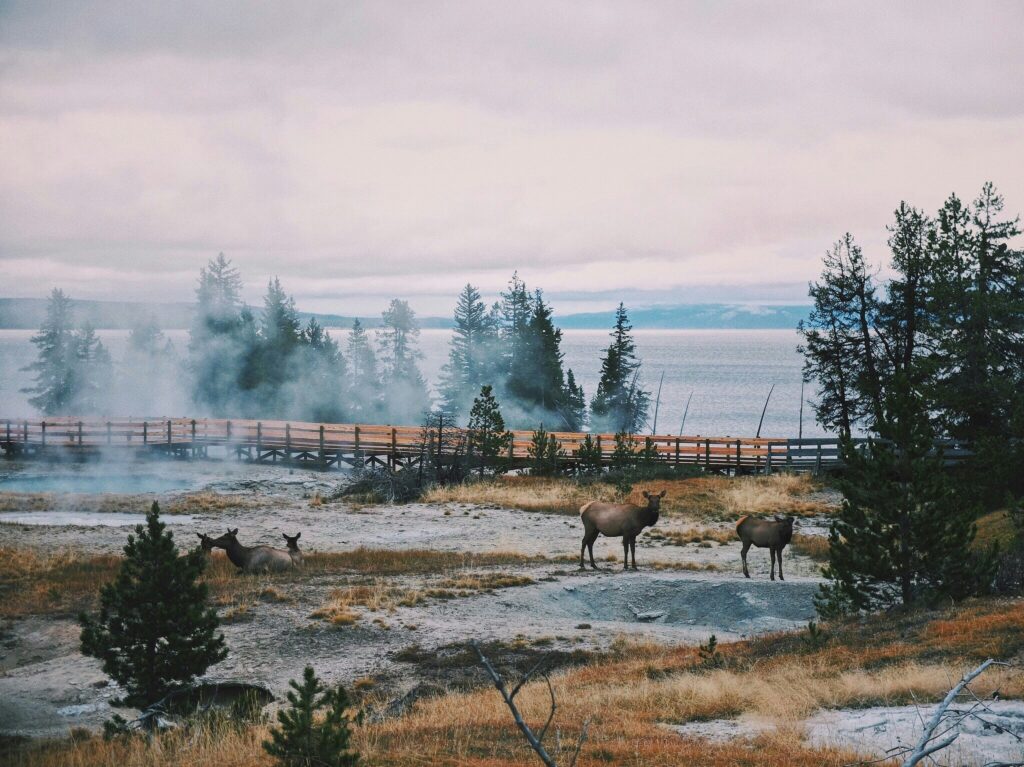
Yellowstone National Park is known for its impressive geothermal features, with Old Faithful being one of the most recognized. This geyser erupts roughly every 90 minutes, drawing crowds who want to see its powerful display. Nearby, the Grand Prismatic Spring stands out for its striking rings of blue, green, and orange, caused by heat-loving bacteria and minerals. These natural features are not just visually impressive—they also highlight the park’s unique geothermal landscape.
Wildlife is another major attraction. Yellowstone is home to bison, elk, grizzly bears, and wolves, among many other species. The Lamar Valley, often called the “Serengeti of North America,” is one of the best places to spot animals in the wild, especially in the early morning or late afternoon. Visitors are reminded to observe from a safe distance to avoid disturbing the animals and to keep everyone safe.
Exploring the park by car is easy thanks to the Grand Loop Road, which connects many of Yellowstone’s key sights, including forests, lakes, and waterfalls. One popular stop is Artist Point, which offers a clear view of the Grand Canyon of the Yellowstone and its waterfalls. For those who want to get off the road, the park has many hiking trails, from short walks to longer, more strenuous hikes like the one up Mount Washburn, which rewards hikers with wide views from the top.
Yellowstone also holds deep cultural and historical value. Long before it became a national park, the land was home to Native American tribes such as the Shoshone and Crow. Their connection to the area is shared through interpretive exhibits and programs. In 1872, Yellowstone became the first national park in the U.S., setting the stage for future conservation efforts across the country.
Efforts to preserve Yellowstone’s ecosystems are ongoing. The park supports a wide range of plants and animals, and there are programs focused on habitat restoration and wildlife management. Ranger-led talks and activities help visitors understand how everything in the park fits together and why protecting it matters.
At night, the park offers some of the clearest views of the stars in the continental U.S. With little light pollution, it’s easy to see the Milky Way and spot planets and constellations. Occasionally, rangers host stargazing events to help visitors explore the night sky in more detail.
Visitor centers like the Albright Visitor Center provide helpful information and interactive exhibits about the park’s natural features and history. Rangers are available to answer questions and recommend hikes, viewpoints, and educational programs. These resources help visitors make the most of their trip and gain a deeper understanding of what makes Yellowstone so special.
Old Faithful
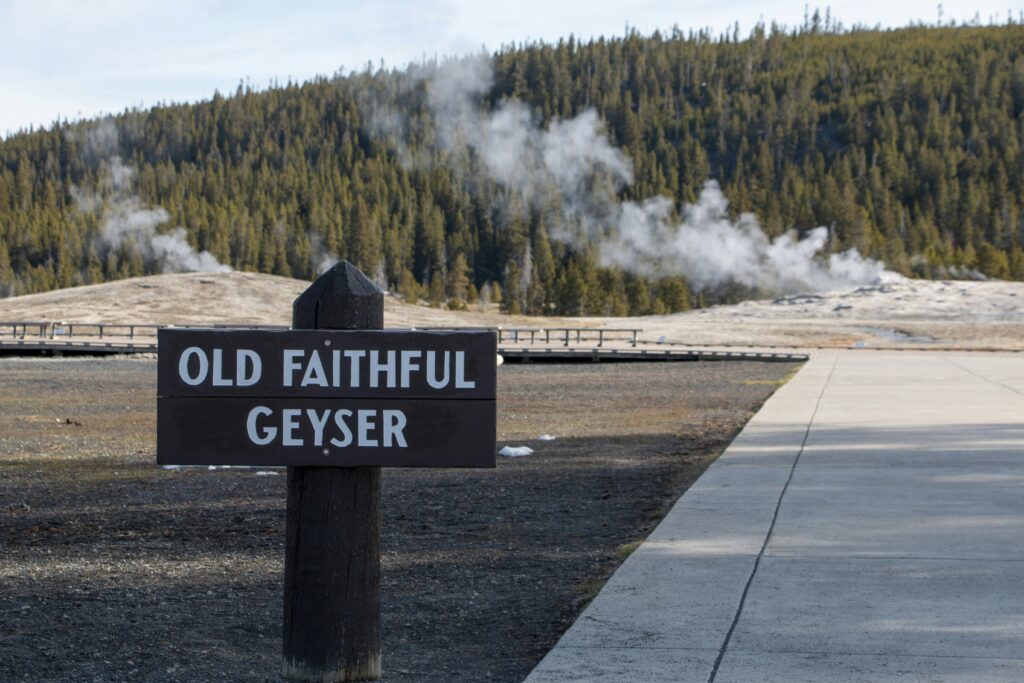
Old Faithful is one of Yellowstone’s most recognized landmarks, drawing thousands of visitors each year. Its eruptions occur roughly every 90 minutes, sending a column of hot water and steam up to 185 feet into the air. Each eruption lasts between two and five minutes, offering a consistent and memorable display of geothermal activity. The experience leaves a strong impression—not just for the height of the water but for the sound, steam, and energy that fill the air.
The geyser’s regular activity is thanks to its underground system of fractures and chambers. Water seeps deep into the ground, where it’s heated by magma before building enough pressure to erupt. This system is part of a larger hydrothermal network that includes hot springs, mud pots, and other geysers spread across the park. Together, they offer insight into the geological forces still shaping Yellowstone today.
Visitors usually gather at the viewing area near Old Faithful, where benches offer a good spot to sit and watch the show. The build-up before each eruption adds to the excitement, and once it begins, the combination of sound, mist, and movement creates a powerful sensory experience. To better understand the science behind it all, the nearby Old Faithful Visitor Education Center provides exhibits and programs that explain how geysers work, the park’s history, and the importance of conservation. Ranger talks here add depth to the visit, especially for those curious about Yellowstone’s ecology and geothermal activity.
The area surrounding Old Faithful offers much more to explore. The Upper Geyser Basin, where it’s located, has the highest concentration of geysers anywhere in the world. Boardwalk trails lead visitors past other notable features like Castle Geyser and Grand Geyser, each with its own eruption style and rhythm. Walking these trails gives a broader view of the geothermal diversity that makes this part of the park so unique.
Wildlife also thrives near the geyser basin. Bison, elk, and sometimes bears can be seen grazing in the nearby meadows. This mix of active geothermal features and roaming wildlife adds a dynamic layer to the landscape. The presence of both helps visitors connect more fully with the natural world Yellowstone protects.
To keep places like Old Faithful pristine, it’s important that visitors follow park rules. Staying on marked paths, giving wildlife space, and respecting all guidelines helps preserve this fragile environment. Yellowstone’s ecosystems are sensitive, and small actions by visitors can make a big difference in their long-term health.
If you are traveling through the USA, join one of our free walking tours and discover the most important citiesGran Prismatic Spring

The Grand Prismatic Spring is one of Yellowstone’s most iconic sights. Spanning over 370 feet in diameter, it’s the largest hot spring in the park and one of the largest in the world. Its bold colors—deep blue at the center, surrounded by rings of green, yellow, and orange—are created by heat-loving microorganisms that thrive in the mineral-rich water. These colors shift slightly depending on the time of year and the temperature, offering something different with each visit.
This hot spring sits in the Midway Geyser Basin, a place shaped by volcanic forces under the Earth’s surface. Water temperatures near the center can reach nearly 190°F, too hot for most forms of life. But as the water cools toward the edges, conditions become suitable for different microbial communities. Each group contributes to the color spectrum that defines the spring, showing how life can adapt to even the harshest environments.
Visitors can explore the area safely thanks to a series of boardwalks. The elevated viewpoint above the spring offers the most striking view and is especially popular with photographers. From up there, you can take in the full scale and shape of the spring, set against a backdrop of forests and rolling hills. It’s a scene that draws visitors from around the world.
The look of the spring changes with the seasons. In warmer months, the microbial mats are more active, bringing out stronger shades of red, yellow, and green. In colder months, while some colors may fade slightly, rising steam adds a surreal quality to the view. Whether it’s summer or winter, the area remains compelling in very different ways.
Those hoping to capture good photos should aim for early morning or late afternoon when the light is softer. The steam and reflections can make for dramatic shots, especially with a wide-angle lens. A polarizing filter can also help reduce glare and bring out the depth of the colors on the water’s surface.
Beyond the Grand Prismatic Spring, the area is filled with other geothermal attractions. Nearby sites like Excelsior Geyser Crater and Opal Pool offer more chances to see Yellowstone’s geothermal diversity up close. Well-maintained paths make it easy to explore multiple features in one visit without straying far from the main road.
Maintaining this fragile environment is a priority for the park. The National Park Service works to protect both the geothermal features and the ecosystems that surround them. Staying on marked trails, avoiding contact with the water, and following posted guidelines are simple but important ways for visitors to help protect the area.
Lake Yellowstone
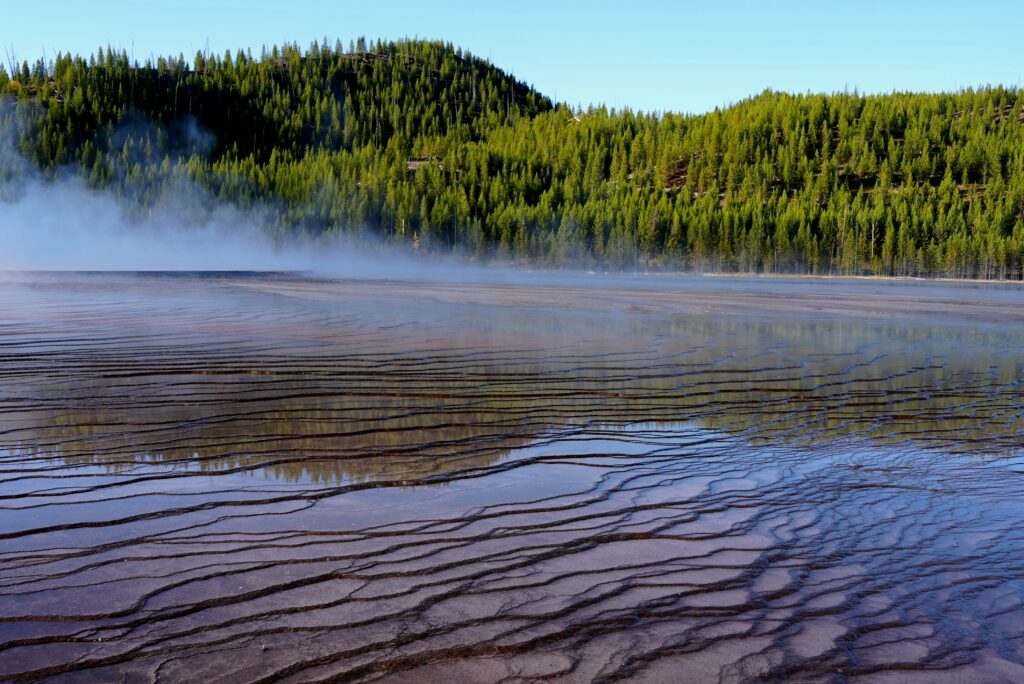
Lake Yellowstone sits high in the heart of Yellowstone National Park, covering around 136 square miles and resting at over 7,700 feet above sea level. Surrounded by forests and mountains, the lake’s deep blue waters offer a peaceful setting for those seeking to experience nature. Its calm surface reflects the landscape around it, drawing in visitors who want to enjoy its quiet beauty.
This lake occupies part of the Yellowstone Caldera, a massive volcanic crater formed over 640,000 years ago. Though the eruption that created it is ancient, the area remains geologically active. Around the lake, you’ll find steaming hot springs and bubbling mud pots that reveal the heat still beneath the surface. West Thumb Geyser Basin is one of the best places to see these features up close, where geothermal activity appears just steps from the shoreline.
Lake Yellowstone is also a great spot for outdoor activities. Fishing is especially popular, with anglers hoping to catch native cutthroat trout. Canoes and kayaks glide along the shoreline, offering a quiet way to take in the scenery. Guided boat tours and fishing trips run out of the Lake Yellowstone Hotel, providing a mix of relaxation and learning for those interested in the area’s ecology and history.
Hikers will find plenty of trails nearby, ranging from short, scenic walks to more strenuous climbs. The Lake Outlet Trail offers an easy route for spotting wildlife, including birds and the occasional river otter. For a tougher hike, Mount Washburn gives those who reach the summit wide views of the lake and the surrounding terrain.
The land around the lake supports a range of wildlife. Bison and elk often graze along the shore, and moose sometimes wade through the shallow waters. Grizzly bears and wolves also move through the area, especially during the early and late parts of the day. Visitors hoping to see animals should bring binoculars and keep a respectful distance to avoid disturbing them.
Birdlife is especially abundant here. The lake is a key stopover for migratory birds during spring and fall, and year-round residents like the common loon and red-tailed hawk are often seen gliding above the water or perched in nearby trees. For birdwatchers, Lake Yellowstone offers a chance to spot species in a setting that feels wild and untouched.
This area also holds deep meaning for Native American tribes, including the Shoshone and Crow, who have long considered the lake a sacred place. Interpretive centers within the park offer programs that explore these histories and honor the connections between the land and the people who have lived here for generations.
Efforts to protect Lake Yellowstone are ongoing. Park staff monitor water quality and work to support native species. Visitors can help by sticking to marked trails, packing out trash, and following wildlife safety guidelines. These simple steps play a big part in keeping the area healthy for the future.
Lower Falls of the Yellowstone River
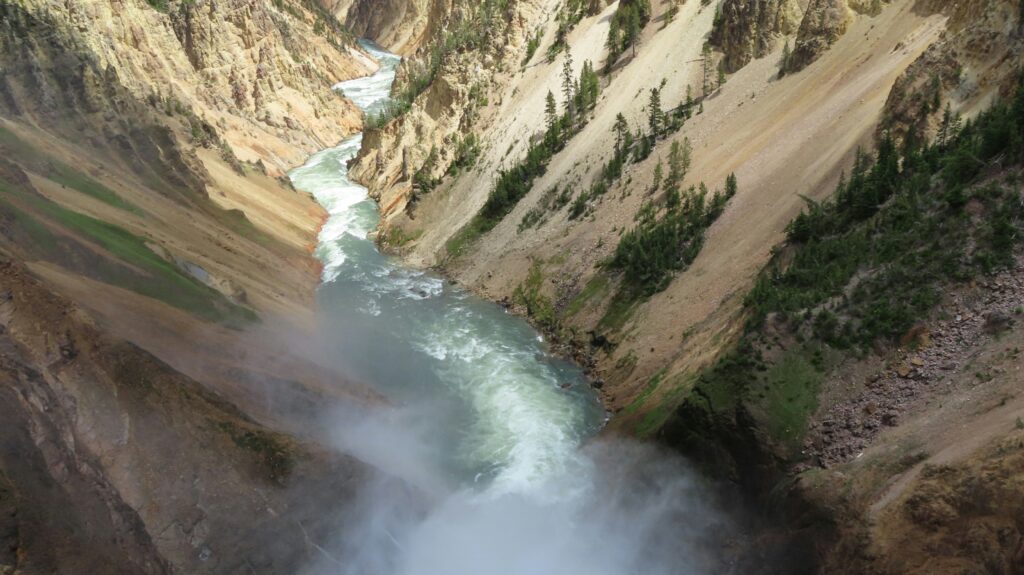
The Lower Falls of the Yellowstone River is one of the most striking features in Yellowstone National Park. Dropping over 300 feet, the waterfall is both powerful and visually impressive, especially when sunlight hits the mist and highlights the golden tones of the surrounding rock. As you near the viewing areas, the sound of the water grows louder, building a sense of anticipation. The scene from Artist Point is one of the most popular, offering a full view of the falls and the canyon they pour into.
The falls are located in the Grand Canyon of the Yellowstone, a dramatic landscape carved by the river over thousands of years. The canyon stretches about 20 miles, with steep cliffs in shades of yellow, red, and green. These colors, set against the deep blue of the river, give the area a surreal, almost painted appearance. Trails along the rim offer several vantage points for taking in the scene. The South Rim Trail and Lookout Point are great options for those who want to explore the area on foot.
This part of the park is also known for its wildlife. Bald eagles often glide above the canyon, while elk may be seen grazing nearby. Early morning and late evening are the best times to spot animals, as they tend to be more active when temperatures are cooler. The chance to observe wildlife in such a dramatic setting makes the visit even more rewarding.
Photographers are drawn to the Lower Falls for its ever-changing light and scenery. In the morning, the canyon glows with soft, warm light, while evenings bring out deeper shadows and highlights. A wide-angle lens can capture the full scale of the falls and canyon, while zoom lenses are useful for picking out details in the rock and water. For those interested in long exposure photography, the flowing water can be turned into smooth ribbons that contrast with the jagged cliffs around it.
Beyond its natural appeal, the area holds cultural meaning for the Native American tribes who have long lived in the region. The falls and canyon have been part of stories and traditions passed down through generations. Learning about these cultural ties can bring a deeper understanding of the place and the people connected to it.
Geyser Basin Norris
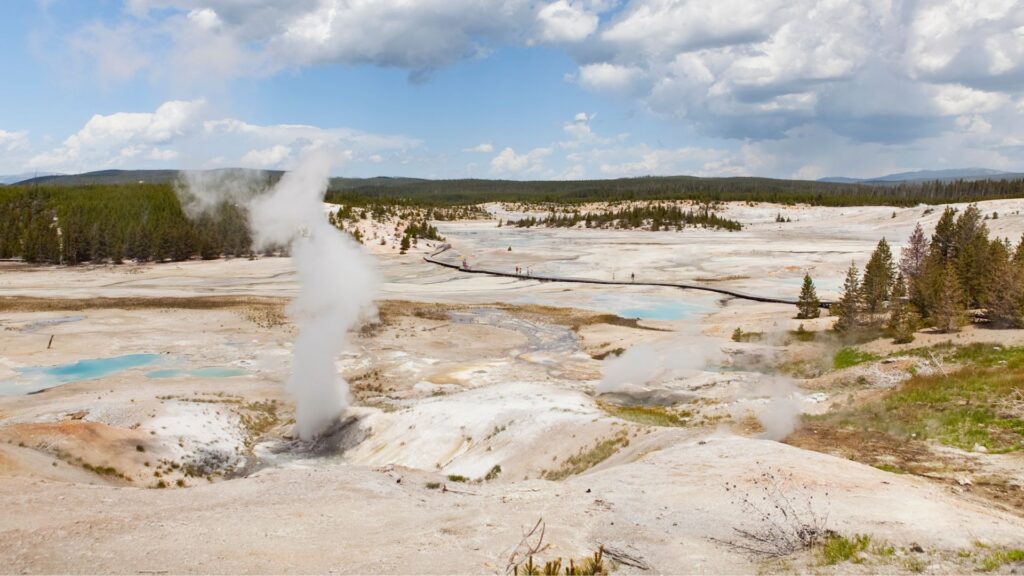
Norris Geyser Basin is one of the most geologically active spots in Yellowstone, known for its extreme heat, strong sulfur smell, and unpredictable geothermal activity. It features Steamboat Geyser—the world’s tallest active geyser—and other dramatic sights like bubbling mud pots and steaming fumaroles in areas such as Porcelain Basin.
The basin’s mineral-rich waters support heat-loving microorganisms that create bold colors across the landscape. Wildlife such as bison and elk are often seen nearby, adding to the unique mix of life and geology.
Visitors can explore safely via boardwalks and trails, with the Norris Museum offering insight into the area’s science and history. Ranger-led walks help explain the dynamic forces at work beneath the surface.
Photographers are drawn to the shifting steam, vivid colors, and rare geyser eruptions, especially at sunrise or sunset. Staying on marked paths is essential to protect the fragile ecosystem. Norris is a place that continually evolves, making each visit a new experience.
Discover the best free walking tours in the USAMammoth Hot Springs Park
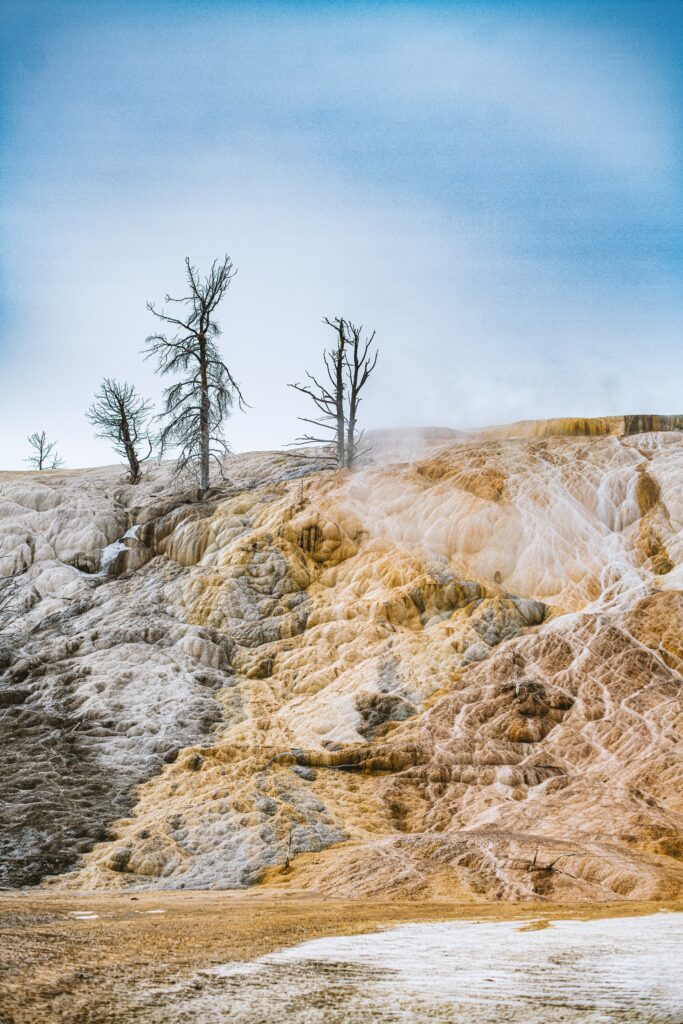
Mammoth Hot Springs is one of Yellowstone’s most distinctive geothermal areas, known for its white and rust-colored terraces formed by calcium carbonate deposits. These step-like structures are shaped by mineral-rich water rising through underground limestone, creating a constantly changing landscape that reflects both geological and biological activity.
Walking along the boardwalks, visitors can see features like Minerva Terrace, where orange and yellow hues are caused by thermophilic bacteria. The terraces grow and shift with changes in water flow and temperature, making each visit slightly different from the last. The scene feels otherworldly, especially when steam drifts through the air.
Wildlife is also common around Mammoth. Elk often graze near the springs, particularly during spring and fall. Birdwatchers may spot species like the American dipper or hawks circling above. Early morning and dusk are the best times for spotting animals when they’re most active.
The area has deep cultural roots as well. Native American tribes once used the hot springs for healing and ceremony, and later, the U.S. Army established Fort Yellowstone nearby to help protect the new national park. Today, visitors can explore the fort’s remains and learn more about the park’s early history.
Mammoth is easy to reach by car, and its trails and boardwalks are accessible to most visitors. The nearby visitor center offers exhibits and ranger talks that explain the science behind the terraces and the role of conservation in preserving them.
Photographers will find Mammoth especially rewarding, with constantly changing steam patterns and colorful textures that look different depending on the time of day. The surrounding hills and shifting light add to the area’s visual appeal.
Hayden Valley

Hayden Valley lies between Yellowstone Lake and the Grand Canyon of the Yellowstone, offering wide views of rolling hills and open meadows. Covering about 30 square miles, it’s especially beautiful in the early morning, when mist rises over the fields and soft light touches the landscape. The valley’s open terrain and quiet atmosphere make it a favorite for those looking to experience Yellowstone’s scenery at a slower pace.
Wildlife is one of the biggest reasons to visit. Bison and elk are often seen grazing in the meadows, and birds of prey like bald eagles and hawks soar overhead. If you’re lucky, you might spot bears—both black and grizzly—from a safe distance. Early mornings and late afternoons are the best times for viewing animals, as many are more active during the cooler parts of the day. Guided tours can offer helpful context about the valley’s wildlife and ecosystems.
The valley also tells part of Yellowstone’s geological story. Shaped by ancient volcanic activity, its mix of wetlands and grasslands is dotted with thermal features. Nearby spots like Mud Volcano and Dragon’s Mouth Spring show just how active the area still is beneath the surface, with bubbling water and rising steam hinting at the forces below.
For those who want to get out and explore, there are trails for walking and birdwatching, and the Yellowstone River along the eastern edge offers fishing and kayaking. The river’s clear waters and surrounding views make it a peaceful place to spend an afternoon. Whether you’re hiking or paddling, the valley offers a range of ways to enjoy the outdoors.
Photographers will find no shortage of inspiration. The changing light at sunrise and sunset brings out warm tones in the grass and hills, and reflections in the river add to the scene’s beauty. Each season brings its own color palette—spring wildflowers, summer greens, autumn golds, and winter snow all give Hayden Valley a different feel.
As with all of Yellowstone, it’s important to be prepared. The weather can change quickly, so bring layers, and always follow park rules to protect the environment and wildlife. Keeping a respectful distance from animals and staying on marked trails helps preserve the area for everyone.
Lake Butte Overlook
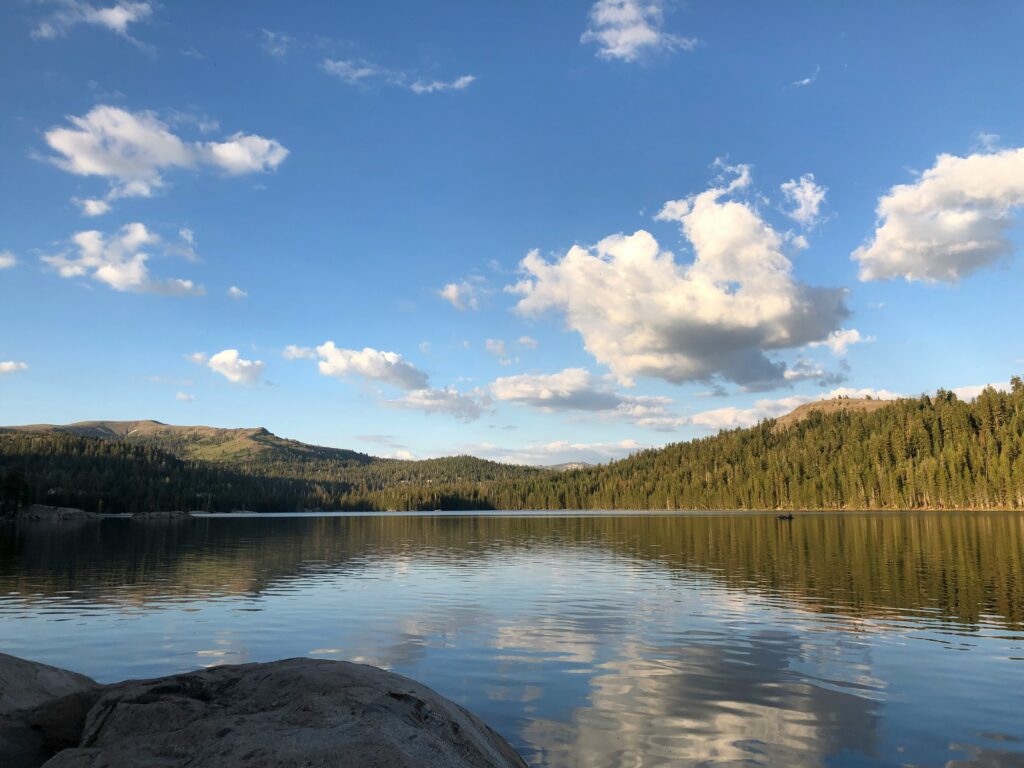
Lake Butte Overlook offers another of best panoramic views of Yellowstone Lake. Located on the lake’s eastern side, it provides a sweeping vantage point over the water and surrounding forests. Sunrise and sunset are especially beautiful here, as soft light reflects off the lake, casting warm colors across the landscape and turning the view into a memorable scene.
The overlook sits above North America’s largest high-elevation lake, which was shaped by glacial activity and rests at over 7,700 feet. From this spot, you can see the vast blue waters framed by distant peaks and tree-covered hills. It’s also a great place for birdwatching—bald eagles, ospreys, and waterfowl are often seen gliding or perched nearby.
Getting to the overlook is easy via a paved road that winds through meadows and forests. The short walk from the parking area to the viewing platform is accessible for most visitors. Along the way, keep an eye out for wildlife. Bison and elk are common in the area, and there’s always a chance of spotting a black bear, so it’s worth having your camera ready.
Photographers will find plenty to capture. The elevated viewpoint allows for wide, open shots of the lake and surrounding terrain. In spring and summer, the area comes alive with wildflowers, adding more color to the scene. Weather patterns can shift quickly, often creating dramatic skies that add texture to photographs taken throughout the day.
Nearby, places like Mary’s Bay and West Thumb Geyser Basin offer more to explore. Mary’s Bay gives visitors a quiet spot along the lake’s shore, while West Thumb features colorful geothermal pools. These stops are close enough to visit in the same outing, making the overlook part of a larger adventure.
Lake Butte is also a solid spot for wildlife viewing. The open views make it easier to scan for movement, especially early or late in the day when animals are more active. Sounds carry across the valley, so you might even hear the calls of birds or elk in the distance.
1 day in Yellowstone – Day trip guide
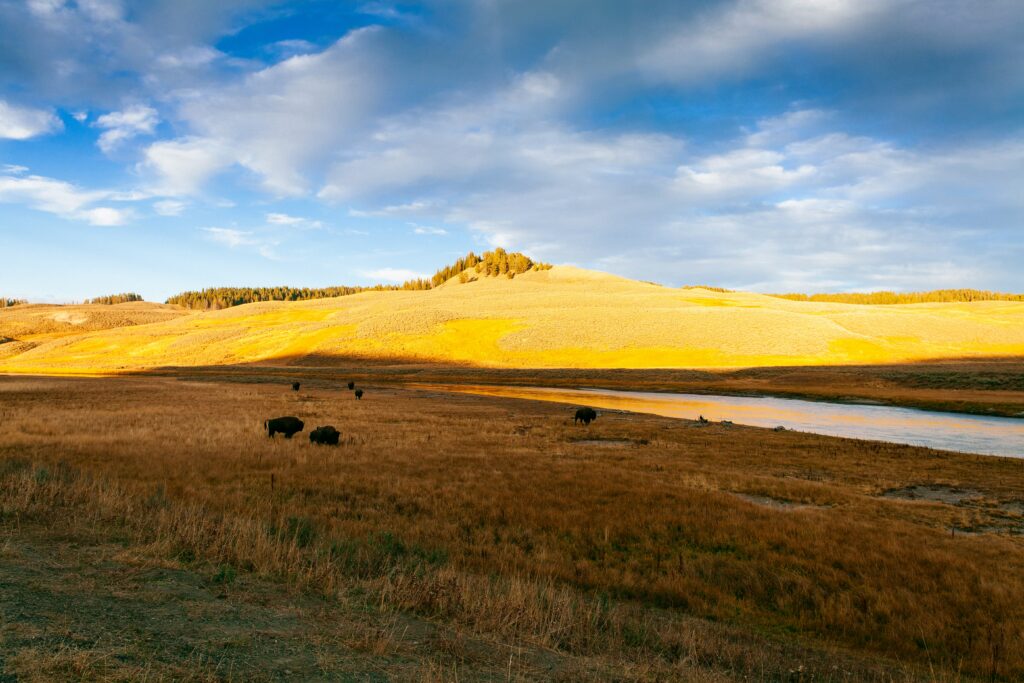
Morning
As the sun rises over the majestic landscapes of Yellowstone, the air is crisp and filled with the promise of adventure. Begin your day at the iconic Old Faithful geyser, where nature’s clockwork unfolds in a spectacular display. Arrive early to secure a good spot, and witness the eruptions that occur roughly every 90 minutes. This mesmerizing natural phenomenon is not just a sight; it’s a reminder of the Earth’s raw power. After the show, take a few moments to explore the surrounding Upper Geyser Basin, where hot springs bubble and steam rises, creating a surreal atmosphere.
Next, make your way to the Morning Glory Pool, a vibrant hot spring known for its stunning colors. The short, scenic hike to the pool offers a wonderful opportunity to immerse yourself in the park’s unique geothermal features. As you stroll, keep your eyes peeled for wildlife, as bison and elk frequently roam the area. Enjoy the tranquility of the morning as you take in the natural beauty that surrounds you.
Afternoon
After a fulfilling morning, it’s time to delve deeper into the wonders of Yellowstone. Head towards the Grand Canyon of the Yellowstone, where breathtaking views await. The canyon’s colorful walls, shaped by centuries of erosion, create a dramatic backdrop for the Lower Falls, which plunges over 300 feet into the gorge below. The vantage points, such as Artist Point, offer magnificent photo opportunities that capture the essence of this majestic landscape.
For lunch, consider a picnic at one of the designated areas, allowing you to recharge while soaking in the scenery. The peaceful sounds of nature and the rustle of leaves provide a perfect soundtrack. After your meal, set out to explore the Lamar Valley, often referred to as the “Serengeti of North America.” This expansive valley is a prime location for spotting wildlife, including wolves, grizzly bears, and herds of bison. Take your time here, as the sights and sounds of the valley are captivating and worth the exploration.
Evening
As the sun begins its descent, the atmosphere in Yellowstone transforms into a golden hour of unparalleled beauty. Make your way to Mammoth Hot Springs, where the travertine terraces glow in the soft light of the evening. The intricate formations created by the thermal waters present a surreal and stunning landscape. Walk along the boardwalks, allowing the warm mineral-rich water to soothe your senses as you marvel at this geological wonder.
To conclude your day in Yellowstone, find a quiet spot to witness the sunset. The view from Mount Washburn offers a panoramic perspective of the park, where the vibrant hues of orange and purple paint the sky above the rugged terrain. It’s a moment of reflection, a chance to appreciate the wild beauty of the world around you. As the stars begin to twinkle in the vast sky, you’ll leave with memories of a day well spent in one of nature’s grandest arenas, feeling inspired by the untamed spirit of Yellowstone.
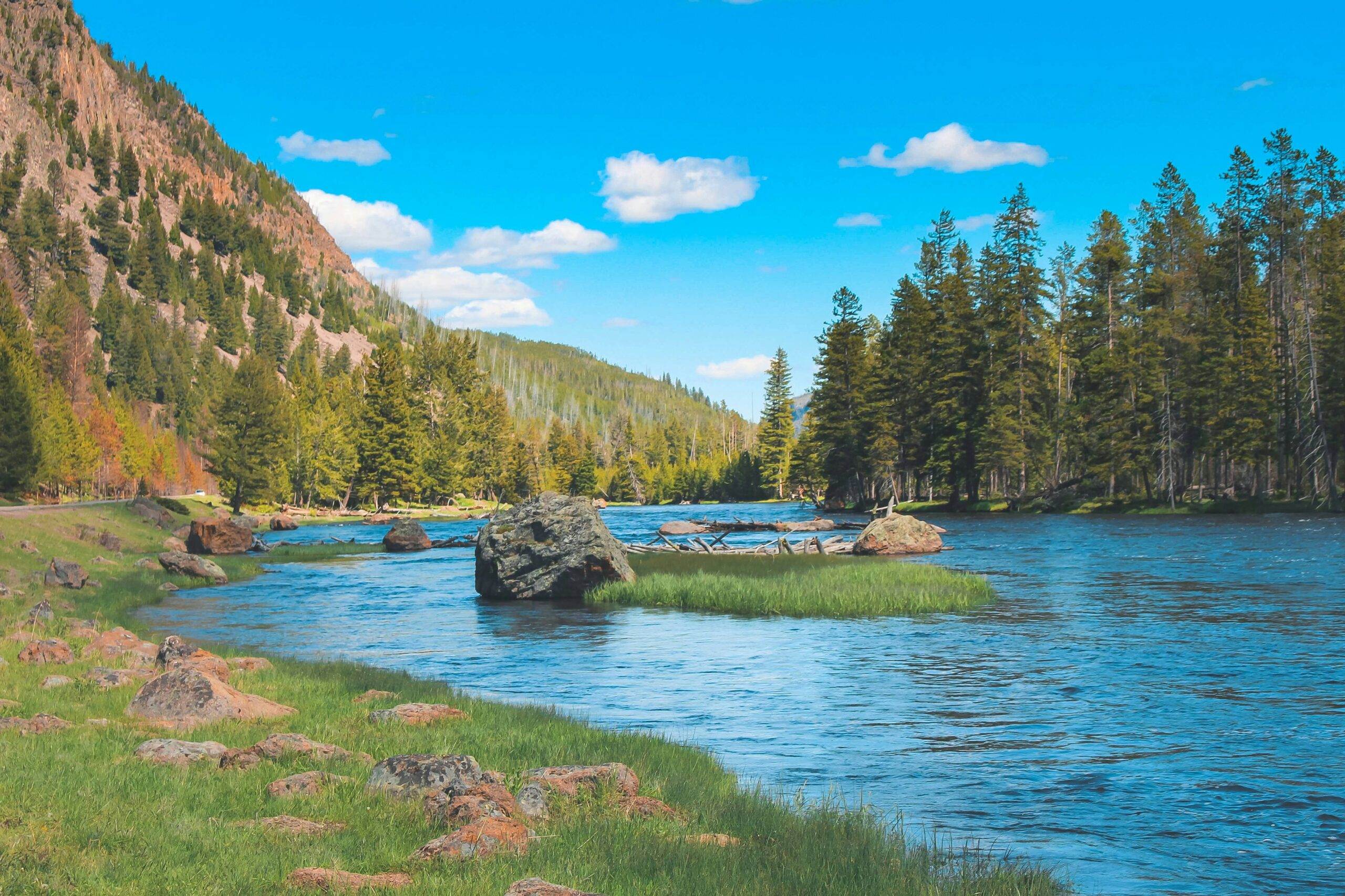


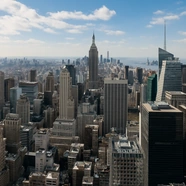
Discover more interesting places to see